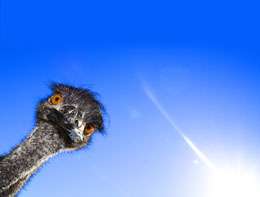Dinosaur extinction grounded ancient birds

(��������Org.com) -- An abundance of food and lack of predators following the extinction of dinosaurs saw previously flighted birds fatten up and become flightless, according to new research from The Australian National University.
The study, led by Dr Matthew Phillips, an ARC Postdoctoral Fellow at the ANU Research School of Biology, looked at the mitochondrial genome sequences of the now-extinct giant moa birds of New Zealand. To their surprise, the researchers found that rather than having a flightless relative, their closest relatives are the small flying tinamous of South America.
Their molecular dating study suggests that the ancestors of the African ostrich, Australasian emu plus cassowary, South American rheas and New Zealand moa became flightless independently, in close association with the extinction of the dinosaurs about 65 million years ago.
“Many of the world’s largest flightless birds, known as ratites, were thought to have shared a common flightless ancestor. We followed up on recent uncertainty surrounding this assumption,” said Dr Phillips.
“Our study suggests that the flighted ancestors of ratites appear to have been ground-feeding birds that ran well. So the extinction of the dinosaurs likely lifted predation pressures that had previously selected for flight and its necessary constraint, small size. Lifting of this pressure and more abundant foraging opportunities would then have selected for larger size and consequent loss of flight.”
The finding of independent origins of flightlessness also solves a mystery of how these flightless birds dispersed across the world over marine barriers - their ancestors flew.
��貹�پ��ٱ� birds have been thought of as relics of the former Gondwanan supercontinent, which combined Africa, South America, Australia, Antarctica, New Zealand, India and Madagascar,” said Dr Phillips.
“Not only have we shown that the separate ratite lineages evolved too recently to have been on Gondwana before its continents drifted apart, but from our analyses we infer that at least ostriches, and possibly ratites as a whole, have their origins in the northern continents.”
The researchers’ paper, Tinamous and Moa Flock Together: Mitochondrial Genome Sequence Analysis Reveals Independent Losses of Flight among Ratites, is published in this month’s issue of the journal Systematic Biology.
Provided by Australian National University
















